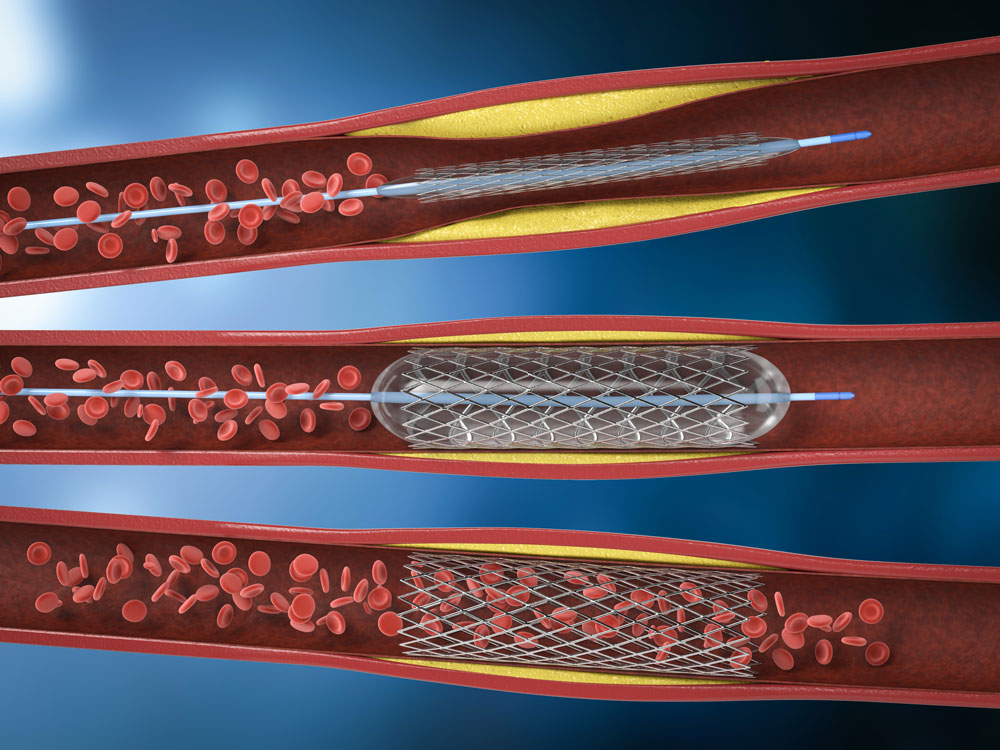
Coronary Angioplasty (Balloon) – Stent Treatment
Coronary angioplasty is used to open the diseased vessel. Balloon application is applied to the diseased artery. This process provides the opening of stenosis and blockages in the heart vessels. Thus, the obstacle in front of the blood flow that the heart needs is removed. Therefore, the obstructed or narrowed part expands.
What is Coronary Angioplasty (Balloon)?
Coronary angioplasty is a treatment method to widen the coronary arteries with vascular occlusion. This procedure aims to widen or break up the plaques in the stenotic artery with a balloon catheter.
How is Coronary Angioplasty (Balloon) Performed?
Coronary angioplasty is usually performed under local anaesthesia. The process takes about 10 – 30 minutes. The following steps are followed when performing balloon angioplasty:
- Patient is anesthetized under local anesthesia.
- The cardiologist inserts a catheter to reach the coronary arteries.
- The balloon is inflated by placing the balloon on the relevant area of the occluded artery. During this process, the blockage opens, and the vessel expands.
- The balloon is withdrawn, and a stent is placed in that area if necessary.
In Which Diseases Is Coronary Angioplasty (Balloon) Applied?
Balloon angioplasty can be used in the following diseases:
- Atherosclerosis: It is the vascular occlusion caused by the accumulation of fatty plaques in the coronary arteries. In the presence of critical stenosis, the procedure is applied.
- Coronary artery disease: It is a heart attack or cardiovascular stenosis caused by occlusion of the coronary arteries.
- Stable Angina: It is a type of pain that occurs for a long time due to stenosis in the coronary arteries and does not change in intensity and duration. If it does not respond to drug treatment, the procedure is applied.
- Unstable Angina: It is a condition that occurs due to stenosis in the coronary arteries, but the severity, type and duration of pain vary.
In Which Situations Is Coronary Angioplasty (Balloon) Performed?
Coronary angioplasty is applied to patients with coronary artery disease, which develops due to the cessation of blood flow due to narrowing and blockages in the coronary arteries feeding the heart muscle. It is also applied to patients who have had a heart attack.
Some complaints are seen due to the decrease in blood flow due to the narrowing of the vessels. These complaints are as follows:
- Fatigue
- Pain in the left arm
- Pain in the jaw
- Stomachache
- Pain in the chest
- Burning feeling in the chest
What is a stent?
A stent is a tool used alone or after coronary angioplasty (balloon angioplasty). It is a metal ring used to treat blockages in the coronary arteries.
What are the Stent Types?
There are two main types of stents used for coronary angioplasty:
- Drug-eluting stent (DES): These are drug-containing stents. These drugs are used to prevent thrombus formation and to maintain vessel width.
- Bare Metal stent (BMS): This type of stents provides vessel width. However, it does not contain drugs to prevent thrombus formation.
How Is Stent Treatment Performed?
Stent treatment includes the following steps:
- Before the procedure, the patient is usually kept under local anesthesia or sedation.
- A catheter is then inserted into the vascular system.
- A stent is advanced through the catheter. The stent is opened in the stenosis area and adhered to the vessel wall.
- After the procedure, the location of the stent and its effectiveness are checked.
- The patient usually stays in the hospital for one night.
What is the Reason for Stent Implantation?
Stent therapy is a treatment option for coronary artery disease (CAD) patients. CAD occurs due to occlusion of the coronary arteries that carry blood to the heart muscle. Therefore, stenting is a treatment to relieve stenosis in the coronary arteries.
What Should Be Considered After Stent?
Things to consider after stent treatment are as follows:
- After the procedure, you should use drugs regularly.
- You should do low-intensity activities.
- You should follow a healthy and balanced diet.
- No smoking.
- Physician examinations should be carried out regularly.
Frequently Asked Questions
-
The risks that may occur during a coronary angioplasty–stent are as follows:
- Clotting
- Bleeding
- Infection
- Stent occlusion
- Problems with anesthesia
-
These risks are rarely seen. However, it can occur as in any interventional procedure.
-
The factors that patients with stent implantationshould pay attention to are as follows:
- You should do bed rest within the first 24 hours.
- You should use blood thinners regularly.
- Follow the diet and exercise program given by the doctor.
- You should only use the medication by consulting a doctor.
- You should not get pregnant without consulting a doctor.
- Not use smoke or alcohol.
-
Recovery time after stent placement varies from person to person. Generally, complete recovery is observed within 1 to 2 weeks.
-
Stents are long-lasting. However, the lifespan of the stents varies according to the location of the treated vessel, the type of stent, and the person's genetics.
-
Coronary angioplasty -stent usually takes 10-30 minutes. The duration of the procedure varies according to the location of the treated vessel, the structure and width of the vessel, the type of stent, and the health status of the person.


